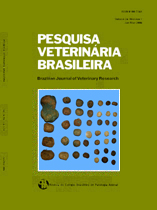 |
|
|
|
Year 2013 - Volume 33, Number 2
|

|
Phenotypic and genotypic analysis of virulence in Staphylococcus spp. and its clonal dispersion as a contribution to the study of bovine mastitis, 33(2):161-170
|
ABSTRACT.- Marques V.F., Souza M.M.S., Mendonça E.C.L., Alencar T.A., Pribul B.R., Coelho S.M.O., Lasagno M. & Reinoso E. 2013. [Phenotypic and genotypic analysis of virulence in Staphylococcus spp. and its clonal dispersion as a contribution to the study of bovine mastitis.] Análise fenotípica e genotípica da virulência de Staphylococcus spp. e de sua dispersão clonal como contribuição ao estudo da mastite bovina. Pesquisa Veterinária Brasileira 33(2):161-170. Departamento de Microbiologia e Imunologia Veterinária, Universidade Federal Rural do Rio de Janeiro, Seropédica, RJ 23890-000, Brazil. E-mail: miliane@ufrrj.br
Mastitis is an inflammation of one or more mammary glands caused mainly by bacteria, among which the genus Staphylococcus plays an important role. Bacteria belonging to this genus are known to express virulence factors which allow their persistence and spread in the host. This study aimed to evaluate the phenotypic and genotypic aspects of virulence factors in Staphylococci spp. isolates from bovine mastitis clinical cases. A total of 272 milk samples from 8 farms in the South-Fluminense region of Rio de Janeiro were analyzed. The samples underwent conventional bacterial identification, yielding 250 Staphylococci spp. isolates. These were tested for the phenotypic detection of slime production by the microplate and Congo Red Agar methods. The hemolysins production, hemolytic synergism, caseinase and DNase production were also evaluated. The isolates were then assayed through the Polymerase Chain Reaction method to detect genes associated with virulence factors such as: capsule (cap5, cap8), fibronectin (fnbA, fnbB), slime (icaA, icaD) and hemolysins (hla e hlb). Regarding the number of isolates assessed, 58% (145/250) were identified as coagulase-negative Staphylococcus spp. and 42% (105/250) as coagulase-positive Staphylococcus spp. The latter comprised 36.2% (38/105) of isolates identified as S. aureus, 11.4% (12/105) as S. intermedius and 3.8% (4/105) belonging to the SIG group. The hemolisin production was not significant, whereas only 6,4% (16/250) produced alfa hemolysis, 4,8% (12/250) produced beta hemolysis and 1,6% (4/250) was able to produce both. Caseinase production was observed in 66.4% (166/250) and slime production assayed through the microplate method was positive in 76,8% (192/250). DNAse was detected in coagulase-negative Staphylococcus spp. (38/145) and in S. aureus (14/38). Low association between genetic detection of icaA (38/250) and icaD (54/250) and slime phenotypic expression (192/250) suggest that others genetic markers can be involved in this expression. Regarding gene amplification, the isolates did not show significant correlation between the genetic detection of icaA (38/250) and icaD (54/250) and slime production (192/250), indicating that other genetic markers may be involved in this trait expression. The frequency of the occurrence of the others studied genes was of 4% (10/250) for cap5 and cap8, 32,8% (82/250) for fnbA, 4,4% (11/250) for fnbB, 19,2% (48/250) for hla and 18% (45/250) for hlb. The major circulating strain profile on the farms encompassed slime and caseinase producer strains. The spaA gene was found in all of the S. aureus isolates, presenting varying amplicons sizes, with 300bp being the prevalent size. The amplification of the coa gene showed nine polymorphic variants, with 600bp being the prevalent amplicon. The agr gene was also detected in every S. aureus isolate, with an amplicon of 200bp. It was noticed that the presence or absence of the virulence genes assayed in this study were not correlated with the 6 distinct electrophoretic profiles obtained by PFGE. |
| |
|
|
| |
|
 |